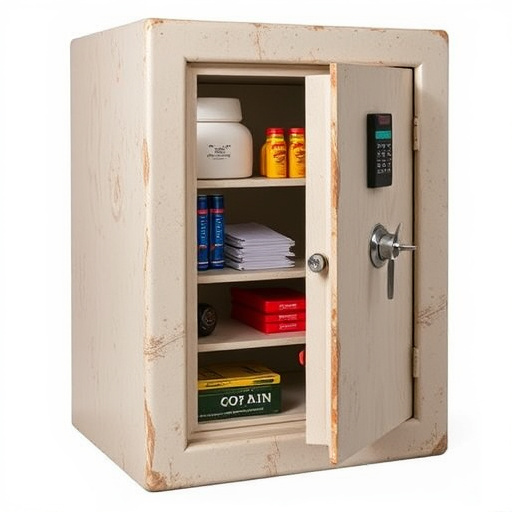Covert storage systems disguised as everyday items like books or kitchen utensils (Stash Box Camouflaged as Products) offer a creative, discreet way to secure valuable items. Meticulously designed and leveraging 3D printing, these stash boxes mimic real products, appealing to those needing secret hiding places for sensitive materials without drawing attention. Ideal for protecting emergency funds, jewelry, documents, or medications, they enhance security but can foster mistrust among loved ones.
Discover the intriguing world of covert storage systems, where everyday objects double as secret stash boxes. In this article, we unravel the concept of seamlessly integrating hidden compartments within seemingly innocent products. From design strategies that masterfully replicate real items to material choices ensuring effective camouflage, we explore how to create convincing fake products. We also delve into ethical considerations and practical applications, offering a unique perspective on enhancing security and organization in daily life with stash box camouflage.
- Understanding the Concept: Unveiling Covert Storage Systems
- Design Strategies: Creating Realistic Fake Products
- Material Choices and Execution for Effective Camouflage
- Ethical Considerations and Applications in Everyday Life
Understanding the Concept: Unveiling Covert Storage Systems
Covert storage systems, often concealed within everyday objects, represent an innovative approach to securing valuable items while maintaining a seemingly innocuous exterior. These cleverly designed stash boxes integrate seamlessly into regular household or office products, offering a unique solution for discreetly stowing away possessions. By masquerading as items like books, plant pots, or even kitchen utensils, these storage systems provide a level of secrecy that conventional safes cannot match.
The concept behind camouflaged stash boxes is to utilize everyday objects as cover, making them nearly invisible to prying eyes. This design philosophy caters to individuals seeking secure hiding places for sensitive materials without drawing attention. Whether it’s safeguarding important documents, precious jewelry, or even emergency funds, these covert storage solutions offer a discrete and practical way to protect personal belongings.
Design Strategies: Creating Realistic Fake Products
In the realm of covert storage systems, designing fake products that blend seamlessly into their surroundings is an art. Crafting realistic replicas involves meticulous attention to detail, from material selection to intricate product design. The goal is to create a stash box camouflaged as everyday items, ensuring it remains hidden from prying eyes. For instance, transforming a discreet storage container into a replica of common household goods like books, cans of food, or even electronic devices requires precise engineering and an understanding of the target market’s behavior.
To achieve this, product designers often study real-world counterparts, analyzing their physical attributes, textures, and packaging to replicate them perfectly. 3D printing technology plays a pivotal role, enabling customization and intricate detailing. By combining innovative design strategies with advanced manufacturing processes, creators can produce fake products that are virtually indistinguishable from authentic ones. This approach ensures the security of valuable items while maintaining an air of normalcy, making it an effective solution for those seeking discreet storage solutions.
Material Choices and Execution for Effective Camouflage
In designing a covert storage system that effectively camouflages stash boxes, material choices play a pivotal role in blending seamlessly with the surrounding environment. The key is to select materials that mimic common household or everyday objects, ensuring discretion while maintaining functionality. For instance, using faux-leather or fabric covers can transform a stash box into an innocuous accessory like a book, wallet, or even a piece of clothing, making it nearly impossible to detect at first glance.
The execution of these design elements is equally important. Precise craftsmanship ensures that the disguised storage unit not only looks authentic but also feels realistic, further enhancing its camouflage. Textures, prints, and colors should be carefully chosen based on the intended environment—a vintage-style stash box might blend better in an old bookcase, while a sleek modern design could pass off as a tech gadget or stylish accessory. This level of detail not only increases the system’s effectiveness but also adds to its overall aesthetic appeal.
Ethical Considerations and Applications in Everyday Life
The use of covert storage systems, particularly stash boxes camouflaged as everyday products, raises several ethical considerations. While these innovative designs offer enhanced security and privacy, they also stir debates about trust and surveillance. Individuals who adopt such systems often do so to protect valuable or sensitive items from theft or prying eyes—a legitimate concern in today’s digital age where personal information is increasingly vulnerable. However, the very nature of these hidden compartments can foster a sense of distrust among family members, friends, and colleagues, potentially damaging relationships.
Applications of stash boxes camouflaged as products permeate everyday life. From hiding emergency funds or valuable jewelry to discreetly storing essential medications or important documents, these covert storage solutions provide peace of mind in various scenarios. In the context of travel, for instance, a cleverly designed stash box disguised as a book or a common household item can safeguard valuables during transit. Similarly, in situations where personal safety is paramount, such as outdoor adventures or visiting unfamiliar places, these hidden compartments offer a layer of security that conventional storage options cannot match.
Covert storage systems, when designed as realistic fake products like stash boxes disguised among everyday items, offer a unique solution for secure hiding. By mastering material choices and camouflage techniques, these innovative designs blend seamlessly into their surroundings. While ethical considerations are vital, the practical applications in everyday life—from enhancing home security to discreet transportation of essential items—make this game-changing approach worth exploring further. Remember that understanding and respecting privacy are key as we navigate this intriguing world of disguised storage.
